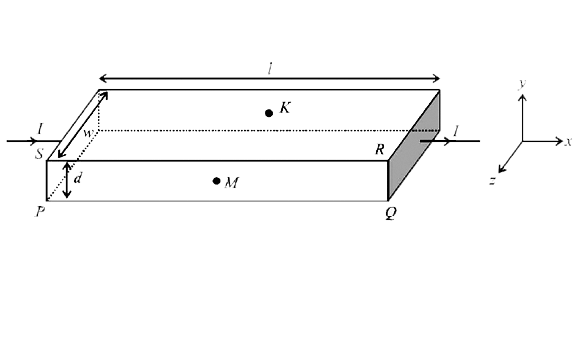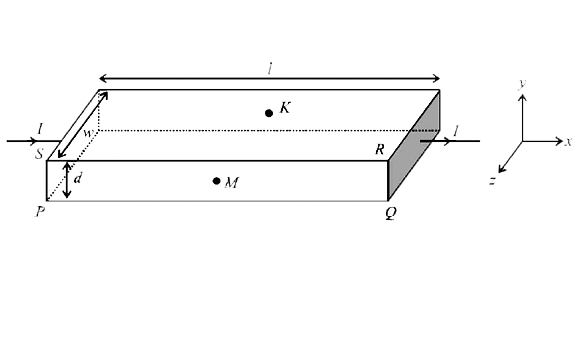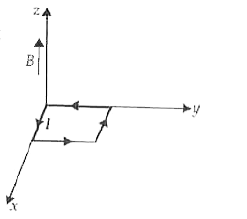In a thin rectangular metallic strip a constant current I flows along the positive x-direction, as shown in the figure. The length, width and thickness of the strip arel, ω and d, respectively.
A uniform magnetic field B is applied on the strip along the positive y direction. Due to this, the charge carriers experience a met deflection along the 2-direction. This results in accumulation of charge carriers on the surface PQRS and appearance of equal and opposite charge on the face opposite to PQRS. A potential difference along the 2 direction is thus developed, Charge accumulation continues until the magnetic force is balanced by the electric force. The current is assumed to be uniformly distributed on the cross section of the strip and carried by electrons.

Consider two different metallic strips (1 and 2) of the same material. Their lengths are the same, widths are ω1 and ω2 and thickness are di and d2, respectively. Two points K and M are symmetrically located on the opposite faces parallel to the x-y plane (see figure). V1 and V2 are the potential differential differences between K and M in strips 1 and 2, respectively. Then, for a given current I flowing through them in a given magnetic field strength B, the correct statement(s) is (are)
If ω1=ω2 and d1=2d2,then V2=2V1
If ω1=ω2 and d1=2d2, then V2=V1
If ω1=2ω2 and d1=d2, then V2=2V1
If ω1=2ω2 and d1=d2, then V2=V1
The correct Answer is:a, d
I=≠Avd⇒vd=I≠A
Let V be the potential difference developed across then electric field can be written as
E=Vω
Electric force is equal to magnetic force.
eE=evdB⇒E=vdB⇒Vω=IB≠A
⇒V=IωB≠A=IωBne(ωd)
⇒V=IB≠d
We can see that potential difference is independent of co but inversely proportional to the d.
We can see that options (a) and (d) are correct.
Topper's Solved these Questions
- MOVING CHARGES AND MAGNETISMBOOK - MODERN PUBLICATIONCHAPTER - MOVING CHARGES AND MAGNETISMEXERCISE - COMPETITION FILE (ASSERTION TYPE QUESTIONS)
10 Videos
- MOVING CHARGES AND MAGNETISMBOOK - MODERN PUBLICATIONCHAPTER - MOVING CHARGES AND MAGNETISMEXERCISE - COMPETITION FILE (MATRIX MATCH TYPE QUESTIONS)
1 Videos
- MOVING CHARGES AND MAGNETISMBOOK - MODERN PUBLICATIONCHAPTER - MOVING CHARGES AND MAGNETISMEXERCISE - COMPETITION FILE (C. MULTIPLE CHOICE QUESTIONS)
28 Videos
- MAGNETISM AND MATTERBOOK - MODERN PUBLICATIONCHAPTER - MAGNETISM AND MATTEREXERCISE - CHAPTER PRACTICE TEST FOR BOARD EXAMINATION
16 Videos
- NUCLEIBOOK - MODERN PUBLICATIONCHAPTER - NUCLEIEXERCISE - CHAPTER PRACTICE TEST FOR BOARD EXAMINATION
15 Videos
Similar Questions
In a thin rectangular metallic strip a constant current I flows along the positive x−direction , as shown in the figure. The length , width and thickness of the strip are l,wandd, respectively.
A uniform magnetic field →B is applied on the strip along the positive y−direction . Due to this, the charge carriers experience a net deflection along the z−direction . This results in accumulation of charge carriers on the surface PQRS ansd apperance of equal and opposite charges on the face opposite to PQRS. A potential difference along the z−direction is thus developed. Charge accumulation contiues untill the magnetic force is balanced by the electric force. The current is assumed to be uniformly distributed on the cross- section of the strip and carried by electrons.
Consider two different metallic strips (1and2) of the same material . Their lengths are the same,widths are w1andw2 and thickness are d1andd2 respectively. Two points KandM are symmetrically located on the opposite faces parallel to the x−y plane ( see figure) . V1andV2 are the potential differences between KandM in strips 1and2, respectively . Then, for a given current I flowing through them in a given magnetic field strength B, the correct statement(s) is (are)

View SolutionIn a thin rectangular metallic strip a constant current I flows along the positive x−direction , as shown in the figure. The length , width and thickness of the strip are l,wandd, respectively.
A uniform magnetic field →B is applied on the strip along the positive y−direction . Due to this, the charge carriers experience a net deflection along the z−direction . This results in accumulation of charge carriers on the surface PQRS ansd apperance of equal and opposite charges on the face opposite to PQRS. A potential difference along the z−direction is thus developed. Charge accumulation contiues untill the magnetic force is balanced by the electric force. The current is assumed to be uniformly distributed on the cross- section of the strip and carried by electrons.
Consider two different metallic strips (1and2) of the same material . Their lengths are the same,widths are w1andw2 and thickness are d1andd2 respectively. Two points KandM are symmetrically located on the opposite faces parallel to the x−y plane ( see figure) . V1andV2 are the potential differences between KandM in strips 1and2, respectively . Then, for a given current I flowing through them in a given magnetic field strength B, the correct statement(s) is (are)

View Solution
Knowledge Check
In a thin rectangular metallic strip a constant current I flows along the positive x−direction,asshown∈thefigure.The≤n>h,whandthick≠ssofthestriparel, w and d,respectively.<br>Auniformmag≠ticfieldvec(B)isappliedonthestripalongthepositivey- direction.Due→this,thechar≥carriersexperiencea≠tdef≤ctionalongthez- direction.Thisrest–s∈auμlationofchar≥carriersonthesurfacePQRSansdapperanceofequalandoppositechar≥sonthefaceopposite→PQRS.Apotentiald⇔erencealongthez-directionisthusdeveloped.Char≥auμlationcontiuesuntillthemag≠ticforceisbalancedbythee≤ctricforce.Thecurrentisas∑ed→beuniformlydistributedonthecross−sectionofthestripandcarriedbye≤ctrons.<br>Consrtwod⇔erentmηllicstrips(1 and 2)ofthesamematerial.Their≤n>hsarethesame,whsarew_(1) and w_(2)andthick≠ssared_(1) and d_(2)respectively.Twop∮sK and Maresymmetricallylocatedontheoppositefacesparal≤l→the x-ypla≠(seefigure).V_(1) and V_(2)arethepotentiald⇔erencesbetweenK and M∈strips 1 and 2,respectively.Then,foragivencurrentIflow∈gthroughthem∈agivenmag≠ticfieldstren>hB, the correct statement(s) is (are)
 AIf w1=w2andd1=2d2,thenV2=2V1BIf w1=w2andd1=2d2,thenV2=V1CIf w1=2w2andd1=d2,thenV2=2V1DIf w1=2w2andd1=2d2,thenV2=V1
AIf w1=w2andd1=2d2,thenV2=2V1BIf w1=w2andd1=2d2,thenV2=V1CIf w1=2w2andd1=d2,thenV2=2V1DIf w1=2w2andd1=2d2,thenV2=V1In a thin rectangular metallic strip a constant current I flows along the positive x−direction,asshown∈thefigure.The≤n>h,whandthick≠ssofthestriparel, w and d,respectively.<br>Auniformmag≠ticfieldvec(B)isappliedonthestripalongthepositivey- direction.Due→this,thechar≥carriersexperiencea≠tdef≤ctionalongthez- direction.Thisrest–s∈auμlationofchar≥carriersonthesurfacePQRSansdapperanceofequalandoppositechar≥sonthefaceopposite→PQRS.Apotentiald⇔erencealongthez-directionisthusdeveloped.Char≥auμlationcontiuesuntillthemag≠ticforceisbalancedbythee≤ctricforce.Thecurrentisas∑ed→beuniformlydistributedonthecross−sectionofthestripandcarriedbye≤ctrons.<br>Consrtwod⇔erentmηllicstrips(1 and 2)ofsamedimensionsn_(1) and n_(2),repectrively.Strip1isplaced∈mag≠ticfieldB_(1)andstrip2isplaced∈mag≠ticfieldB_(2),⊥halongpositive y- directions.Then V_(1) and V_(2)arethepotentiald⇔erencesdevelopedbetweenK and M∈strips1and2,respectively.As∑∈gtˆthecurrentI is the same for both the strips, the correct option(s) is (are)
 AIf B1=B2andn1=2n2,thenV2=2V1BIf B1=B2andn1=2n2,thenV2=V1CIf B1=2B2andn1=2n2,thenV2=0.5V1DIf B1=2B2andn1=2n2,thenV2=V1
AIf B1=B2andn1=2n2,thenV2=2V1BIf B1=B2andn1=2n2,thenV2=V1CIf B1=2B2andn1=2n2,thenV2=0.5V1DIf B1=2B2andn1=2n2,thenV2=V1Positively charged particles are projected into a magnetic field. If the direction of the magnetic field is along the direction of motion of the charged particles, the particles get
AAcceleratedBDeceleratedCDeflectedDNo change in velocity
In a thin rectangular metallic strip a constant current I flows along the positive x-direction , as shown in the figure. The length , width and thickness of the strip are l,wandd, respectively.
A uniform magnetic field →B is applied on the strip along the positive y−direction . Due to this, the charge carriers experience a net deflection along the z−direction . This results in accumulation of charge carriers on the surface PQRS ansd apperance of equal and opposite charges on the face opposite to PQRS. A potential difference along the z−direction is thus developed. Charge accumulation contiues untill the magnetic force is balanced by the electric force. The current is assumed to be uniformly distributed on the cross- section of the strip and carried by electrons.
Consider two different metallic strips (1and2) of same dimensions n1andn2, repectrively . Strip 1 is placed in magnetic field B1 and strip 2 is placed in magnetic field B2 , both along positive y−directions. Then V1andV2 are the potential differences developed between KandM in strips 1 and 2 , respectively . Assuming that the current I is the same for both the strips, the correct option(s) is (are)

View SolutionIn a thin rectangular metallic strip a constant current I flows along the positive x-direction , as shown in the figure. The length , width and thickness of the strip are l,wandd, respectively.
A uniform magnetic field →B is applied on the strip along the positive y−direction . Due to this, the charge carriers experience a net deflection along the z−direction . This results in accumulation of charge carriers on the surface PQRS ansd apperance of equal and opposite charges on the face opposite to PQRS. A potential difference along the z−direction is thus developed. Charge accumulation contiues untill the magnetic force is balanced by the electric force. The current is assumed to be uniformly distributed on the cross- section of the strip and carried by electrons.
Consider two different metallic strips (1and2) of same dimensions n1andn2, repectrively . Strip 1 is placed in magnetic field B1 and strip 2 is placed in magnetic field B2 , both along positive y−directions. Then V1andV2 are the potential differences developed between KandM in strips 1 and 2 , respectively . Assuming that the current I is the same for both the strips, the correct option(s) is (are)

View SolutionPositively charged particles are projected into a magnetic field. If the direction of the magnetic field is along the direction of motion of the charged particles, the particles get
View SolutionA uniform magnetic field of 1000 G is established along the positive z-direction. A rectangular loop of sides 10 cm and 5 cm carries a current of 12 A. What is the torque on the loop as shown in the figure?

View SolutionA uniform magnetic field of 1000 G is established along the positive z-direction. A rectangular loop of sides 10 cm and 5 cm carries a current of 12 A. What is the torque on the loop as shown in the figure?

View Solution
